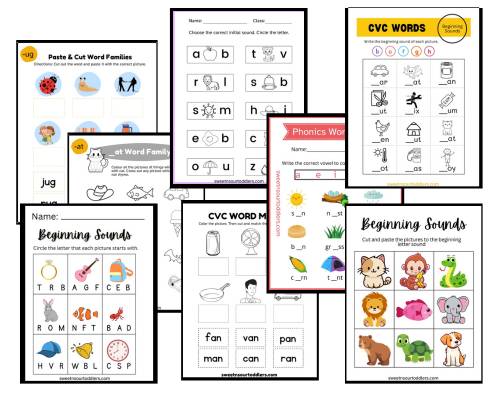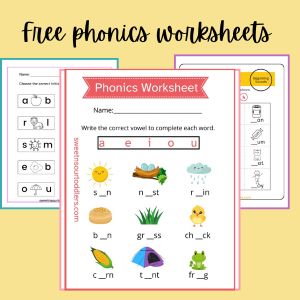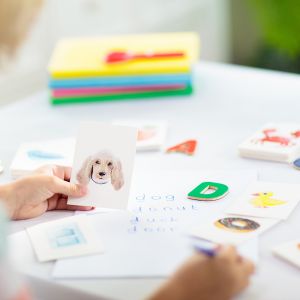Dealing with a child who is struggling to read? Here are 10 super effective strategies to teach struggling readers.
Fostering a love for reading in young children is a journey that comes with its unique set of challenges. Every child learns at their own pace, and it’s not uncommon for some to face hurdles when diving into the world of words.
As a fellow parent navigating the enchanting world of early literacy, I understand the challenges that come with building reading fluency.
Every child’s journey is unique, and in this post, I’ll share not just strategies but snippets from my own parenting experience on how to make the process enjoyable.
I often get questions about how I managed to teach my 2.5 year old reading. Most people are simply astounded.
In this post I want to share the tips and tricks that truly worked for me.
But first, I want to point out a disclaimer. Even before you begin to teach your child reading, there are certain pre-reading skills that are super important for your child to master.
You can read more about these pre-reading skills in this post of mine here.
This post is about strategies to teach struggling readers
This page contains affiliate links. If you choose to purchase after clicking a link, I may receive a commission at no extra cost to you.
Tip 1: Create a Reading-Friendly Environment
One of the fundamental strategies to teach struggling readers is to establish a comfortable and inviting reading space at home. Surround your child with books in various areas, making reading a natural and enjoyable part of their daily environment.
In our home, I transformed a cozy corner into a reading nook, complete with soft cushions and fairy lights. This became our little haven where stories came alive.
You can read more about creating a magical reading corner in this post.

Tip 2: Read Aloud Together
Reading aloud is a powerful tool in developing a child’s reading skills. Regularly engage in shared reading experiences, asking questions, and sparking discussions about the story. This strategy not only builds literacy skills but also nurtures a love for storytelling.
I vividly remember the joy on my child’s face as we delved into magical worlds through books. Even on busy days, we’d find time for a quick story, fostering a connection that transcended the pages.
Tip 3: Choose Age-Appropriate Books
This post contains affiliate links. As an Amazon Associate I earn from qualifying purchases.
Tailor your book selections to match your child’s interests and reading level. Diversify genres to capture their attention and make the reading experience enjoyable.
Aligning book choices with your child’s developmental stage is a key component of effective strategies to teach struggling readers.

Navigating the world of age-appropriate books wasn’t always easy. My secret?
Asking for recommendations from teachers and friends who shared similar struggles, ensuring our bookshelf was a treasure trove of captivating tales.
Here are some easy to read (and fun to read!) books for toddlers:
Tip 4: Be Patient and Encouraging
Patience is a virtue when teaching a struggling reader. Avoid putting undue pressure on your child, and instead, focus on positive reinforcement.
Celebrate small victories along the way, creating a supportive atmosphere that fosters confidence.
One thing that really helps is to not compare your child (and their progress) with any other child.
It’s particularly important to remember to not compare your own children!
Tip 5: Use Phonics and Phonemic Awareness
If there is one tip that you take from this article, let it be this: do not underestimate the power of phonics.
If you don’t already know, phonics is simply the understanding that each individual letter makes a sound. And the different sounds of each letter combined together forms a word.
Phonemic awareness is being able to identify and manipulate the individual sounds in spoken words.
A lot of reading methods teach children to read by memorizing sight words.
This is NOT the correct methodology of teaching reading. In fact, this may very well be the reason your child is struggling with reading.
Instead, the correct method is to focus on teaching phonics and phonemic awareness.
Not sure where to start?
Honestly I was in the exact same boat. How do I begin teaching when I myself don’t know the correct methodology?
That’s when I stumbled upon this reading program that literally changed my child’s reading trajectory.
The program is called Children Learning Reading and is designed to teach children as young as 2 years old how to read!
It’s methodological, step by step and the results have been incredible for me (and thousands of other elated parents).
The best part is that you literally have to take out only 10 minutes a day to see some amazing results within a few weeks.
You can check out my review of Children Learning Reading here where I go over exactly what helped my 2 year old learn reading at such a young age.
Tip 6: Make Reading FUN
You want your kids to excel at reading? The quickest and easiest way is to make reading fun for them. It should never feel like a chore!
When teaching my 2 year old to read, I’d make the whole thing into a game. We’d do so many fun reading activities together – she would always be begging if we could play more!
If something is fun, your kids will want to do it more and more. And that repetition is exactly what will help them achieve reading fluency.
I’ve put together some really fun and engaging reading activities that your little one will LOVE DOING! They cover the fundamentals of reading like beginning sounds, CVC words and word families etc and are simple enough for a 2-3 year old to do easily. They also incorporate super fun elements like matching, cutting and pasting, coloring and tracing.
Get your free download!

Tip 7: Make Reading a Routine
Consistency is key when it comes to learning to read. Establish a daily reading routine, making it an integral part of your child’s day. Whether it’s bedtime stories or afternoon reading sessions, routine forms a solid foundation within strategies to teach struggling readers.
Our bedtime routine involved reading, snuggled under blankets with a favorite book. This ritual not only eased the bedtime transition but made reading an anticipated and cherished part of the day.
Tip 8: Seek Professional Guidance
If concerns persist, don’t hesitate to seek advice from teachers or reading specialists. Early intervention and specialized support can make a significant difference.
Seek guidance from your child’s teacher which can help provide valuable insights.
Tip 9: Foster a Love for Words
Outside formal reading sessions, explore creative ways to build your child’s vocabulary. A rich vocabulary is closely tied to successful reading. Instilling a love for words in your child contributes to broader strategies for teaching struggling readers.
Outside our reading sessions, we played word games during daily activities. From grocery shopping to car rides, the world became a canvas for expanding vocabulary, making language a living, breathing entity.
Tip 10: Lead by Example
Children often mirror the behaviors of their caregivers. Demonstrate a love for reading through your own habits. By leading by example, you are instilling a lifelong love for learning and literature, an integral aspect of effective strategies to teach struggling readers.
Conclusion
Teaching a struggling reader is a journey intertwined with personal moments of frustration, anxiety and triumph. By creating a reading-friendly environment, incorporating engaging activities, and following a proven system, I’ve seen my child’s love for reading flourish.
In your own unique way, embrace the process. Celebrate the small victories, share laughter over a well-loved story, and relish the growth that unfolds with every page turned.
Together, let’s make the journey of learning to read a cherished chapter in your child’s story.
This post was about strategies to teach struggling readers
Don’t forget to grab your free phonics activity sheets below!
Read these posts next:
10 Inspiring Ideas For Setting Up An Insanely Cute Toddler Reading Corner
Children Learning Reading Review – An Honest Opinion From a Mom
10 Super Fun Phonics Activities to Boost Your Child’s Reading Skills





Leave a Reply